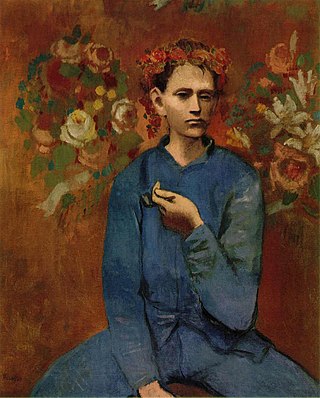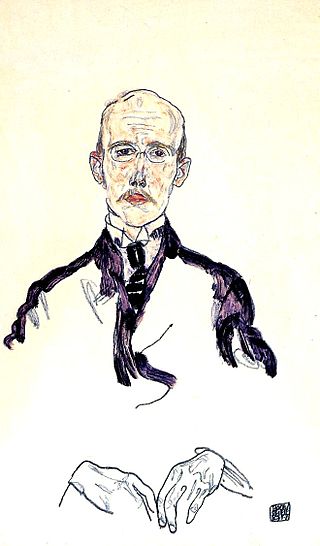Related Research Articles

The Museum of Modern Art (MoMA) is an art museum located in Midtown Manhattan, New York City, on 53rd Street between Fifth and Sixth Avenues. The institution was conceived in 1929 by Abby Aldrich Rockefeller, Lillie P. Bliss, and Mary Quinn Sullivan. Initially located in the Heckscher Building on Fifth Avenue, it opened just days after the Wall Street Crash. The museum, America's first devoted exclusively to modern art, was led by A. Conger Goodyear as president and Abby Rockefeller as treasurer, with Alfred H. Barr Jr. as its first director. Under Barr's leadership, the museum's collection rapidly expanded, beginning with an inaugural exhibition of works by European modernists. Despite financial challenges, including opposition from John D. Rockefeller Jr., the museum moved to several temporary locations in its early years, and John D. Rockefeller Jr. eventually donated the land for its permanent site.

André Derain was a French artist, painter, sculptor and co-founder of Fauvism with Henri Matisse.

Garçon à la Pipe is an oil on canvas painting by Pablo Picasso. It was painted in 1905 when Picasso was 24 years old, during his Rose Period, soon after he settled in the Montmartre area of Paris. The painting depicts a Parisian adolescent boy who holds a pipe in his left hand and wears a garland of flowers on his head, surrounded by two floral decorations. The subject was a local boy named "P’tit Louis" who died at a young age. The painting is listed as one of the most expensive paintings, after being sold at Sotheby's auction for $104 million on 5 May 2004. It is currently the fifth highest selling painting by Picasso.
The Moulin de la Galette is a windmill and associated businesses situated near the top of the district of Montmartre in Paris. Since the 17th century the windmill has been known for more than just its milling capabilities. Nineteenth-century owners and millers, the Debray family, made a brown bread, galette, which became popular and thus the name of the windmill and its businesses, which have included a famous guinguette and restaurant. In the 19th century, Le Moulin de la Galette represented diversion for Parisians seeking entertainment, a glass of wine and bread made from flour ground by the windmill. Artists, such as Renoir, van Gogh, Ramón Casas and Pissarro have immortalized Le Moulin de la Galette; likely the most notable was Renoir's festive painting, Bal du moulin de la Galette.

The Rose Period comprises the works produced by Spanish painter Pablo Picasso between 1904 and 1906. It began when Picasso settled in Montmartre at the Bateau-Lavoir among bohemian poets and writers. Following his Blue Period – which depicted themes of poverty, loneliness, and despair in somber, blue tones – Picasso's Rose Period represents more pleasant themes of clowns, harlequins and carnival performers, depicted in cheerful vivid hues of red, orange, pink and earth tones.
The Blue Period comprises the works produced by Spanish painter Pablo Picasso between 1901 and 1904. During this time, Picasso painted essentially monochromatic paintings in shades of blue and blue-green, only occasionally warmed by other colors. These sombre works, inspired by Spain and painted in Barcelona and Paris, are now some of his most popular works, although he had difficulty selling them at the time.

The Bavarian State Painting Collections, based in Munich, Germany, oversees artwork held by the Free State of Bavaria. It was established in 1799 as Centralgemäldegaleriedirektion. Artwork includes paintings, sculptures, photographs, video art and installation art. Pieces are on display in numerous galleries and museums throughout Bavaria.

Jeune garçon au cheval is an oil on canvas painting by Pablo Picasso. The painting is housed in the Museum of Modern Art in New York. It was painted in Picasso's Rose Period from 1905 to 1906, when he was still a struggling artist living in Paris. The painting is a study for a much larger composition that Picasso never completed.

Le Moulin de la Galette is the title of several paintings made by Vincent van Gogh in 1886 of a windmill, the Moulin de la Galette, which was near Van Gogh and his brother Theo's apartment in Montmartre. The owners of the windmill maximized the view on the butte overlooking Paris, creating a terrace for viewing and a dance hall for entertainment.
Weyhe Gallery, established in 1919 in New York City, is an art gallery specializing in prints. It is now located in Mount Desert, Maine.

Justin K. Thannhauser (1892–1976) was a German art dealer and collector who was an important figure in the development and dissemination of modern art in Europe.
Woman Ironing is a 1904 oil painting by Pablo Picasso that was completed during the artist's Blue Period (1901—1904). This evocative image, painted in neutral tones of blue and gray, depicts an emaciated woman with hollowed eyes, sunken cheeks, and bent form, as she presses down on an iron with all her will. A recurrent subject matter for Picasso during this time is the desolation of social outsiders. This painting, as the rest of his works of the Blue Period, is inspired by his life in Spain but was painted in Paris.

Karl Mayländer was an Austrian art collector and businessman who was deported in 1941 from Vienna to Łódź, in German-occupied Poland, by the Nazis and later murdered in the Shoah.

Many priceless artworks by the Dutch post-impressionist artist Vincent van Gogh were looted by Nazis during 1933–1945, mostly from Jewish collectors forced into exile or murdered.
Carl Christoph Friedrich Bernoulli was a Swiss art dealer and interior designer from the Bernoulli family of scholars.

Paul Robert Ernst von Mendelssohn-Bartholdy was a German Jewish banker and art collector. The persecution of his family under the Nazis has resulted in numerous lawsuits for restitution.
Lotte von Mendelssohn-Bartholdy was a German author and art collector.
References
- ↑ "Pièce de la semaine : Le Moulin de la Galette | Picasso". celebracionpicasso.es. Retrieved 2023-12-08.
- ↑ "Le Moulin de la Galette, 1900 by Pablo Picasso". www.pablopicasso.org. Retrieved 2023-12-08.
- ↑ "Pablo Picasso | Le Moulin de la Galette". The Guggenheim Museums and Foundation. Retrieved 2023-12-08.
- 1 2 "Lawsuits: Mendelssohn-Bartholdy Claims 2008-2009". www.lootedart.com. Retrieved 2023-12-07.
- ↑ "Deux toiles de Picasso réclamées à des musées américains". RTL Info (in French). 2008-08-16. Retrieved 2023-12-07.
- ↑ Times, Alan Feuer the New York (2007-12-21). "Banker's heir sues MoMA, Guggenheim for Picassos". Arizona Daily Star. Retrieved 2023-12-07.
- ↑ "Deux Picasso réclamés à New York". Connaissance des Arts (in French). 2008-08-21. Retrieved 2023-12-07.
- ↑ "Nazi Looted Art in the Second Circuit: Recent Developments". www.lootedart.com. Retrieved 2023-12-08.
The second case, Museum of Modern Art and the Solomon R. Guggenheim Foundation v. Schoeps, involves claims by the heirs of German banker and art collector Paul von Mendelssohn-Bartholdy for title to two well known paintings by Pablo Picasso: Boy Leading a Horse (1906) and Le Moulin de la Galette (1990).
- ↑ Sontheimer, Michael (2008-08-20). "Trans-Atlantic Art Spat: European Heirs Demand New York Museums Return Picassos". Der Spiegel. ISSN 2195-1349 . Retrieved 2023-12-09.
- ↑ Henry, Marilyn (31 March 2009). "Exploiting the restitution environment". lootedart.com. The Jerusalem Post. Retrieved 2023-12-08.
- ↑ "International Foundation for Art Research (IFAR)-Case Summary-Schoeps v. Museum of Modern Art". www.ifar.org. Retrieved 2023-12-08.
- ↑ "Schoeps v. The Museum of Modern Art et al, No. 1:2007cv11074 - Document 119 (S.D.N.Y. 2009)". Justia Law. Retrieved 2023-12-08.
Schoeps v. The Museum of Modern Art et al, No. 1:2007cv11074 - Document 119 (S.D.N.Y. 2009). Court Description: OPINION #97004, that although the Court has also considered, and rejected, various other arguments made by the Museums, the foregoing expresses the basic reasoning underlying the Court's Order of December 30, 2008 denying the Museums' motion for summary judgment, as well as the supplemental Order of January 20, 2009.. (Signed by Judge Jed S. Rakoff on 1/26/09) (pl) Modified on 1/28/2009 (mro).
- ↑ "Guggenheim Settles Litigation and Shares Key Findings". The Guggenheim Museums and Foundation. Retrieved 2023-12-07.
- ↑ Kearney, Christine (February 2, 2009). "NY museums settle in claim of Nazi-looted Picassos". Reuters. Archived from the original on December 1, 2017.
- ↑ "Caché dans un tableau de Picasso pendant un siècle, un surprenant personnage sort de l'ombre". Connaissance des Arts (in French). 2023-06-08. Retrieved 2023-12-08.